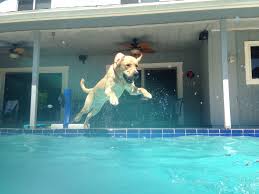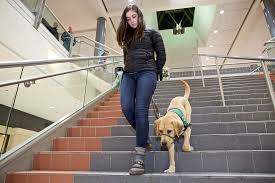What kind of Over-exercise can harm my Labrador?
This blog is SO overdue. I’m sad to say, I hate to witness situations where clients over-exercised their dogs to the point of injury to see how important this is.
I cannot stress enough how important it is during the first 24 months of a large breed dog’s life to be careful about overstressing the joints, bones, and ligaments. This can lead to early injury, arthritis, and joint issues that may require expensive surgeries. The growth plates are not finished growing until 24 months old, so any stress during that time–whether excess weight or too much strain on joints–can cause long-term, irreversible damage.
There is a “genetic component,” but if a breeder has worked hard over 3-5 generations to screen each and every dog bred, but then the owner puts undue stress on these tender, young elbows, hips and other joints, all the great breeding in the world cannot overcome this.
Dr. Karen Becker (DVM) of Mercola Healthy Pets Stresses:
- Most cases of canine arthritis are caused by either a developmental disorder like hip dysplasia, or an acquired condition like a cranial cruciate ligament tear. Other common and preventable causes are too-fast growth in large/giant breed puppies, obesity, and lack of regular (moderate!) exercise.
- Preventing slips, trips, and falls in a growing puppy will help him avoid orthopedic problems that lead to arthritis later in life. Also important in preventing joint degeneration: controlling the growth of large breed puppies through diet, and maintaining your adult dog at a healthy weight and in good physical condition
- There are many things dog guardians can do to prevent, delay, and/or manage symptoms of canine arthritis, including providing chiropractic care, acupuncture, physical therapy, and appropriate joint-protecting supplements
Also READ THIS ARTICLE IF YOU ARE CONTEMPLATING JOGGING WITH YOUR LAB
Be very cautious of allowing dogs to leap repeatedly into pools as well. This can cause great injury to the joints as well as lead to possible cruciate ligament tear. Leaping for Frisbees and lunging for a tennis ball over a long range of time can be devastating to a Labrador’s joints also. Although I enjoy the photos sent to me of my “grand-pups” leaping into pools, I cringe as I imagine what the owner is doing to that poor animal’s joints. Our dogs would not “sprint” back in forth for 20 + minutes a day in the wild. That is over-doing it, especially in a younger dog (under 24 mos) whose growth plates are still growing.
Kim O-Brian of Dogster magazine says, “Do walks instead of a run, do more frequent but shorter walks rather than one long walk, and limit the number of fetches in the front yard. Swimming is a good alternative if your dog has joint problems (but no leaping into pools!). If, for some reason, you need to cut back on activity for more than a few days, be sure to adjust your dog’s feedings appropriately or they will start to put on weight.” (http://www.dogster.com/lifestyle/dog-health-dogs-too-much-exercise)
Nicole Wilde of Modern Dog Magazine adds:
“Taking your pup for brief walks in a health-safe area is fine, but jogging with him or allowing him to jump or engage in high-impact activities is not. A pup’s bones are soft and are therefore at risk of damage—they don’t ossify until approximately 18 months of age. Don’t allow young pups to run up and down stairs, jump in and out of vehicles, or engage in any type of jarring activity.
Note: Many humans who jog for many years end up with joint issues and knee replacements. Its the same with our canine family members. If we pound and pound those joints on pavement or hard ground over and over, damage WILL occur.
Daily short periods of controlled exercise are best. Play with your pup in the house, and practice basic obedience exercises such as sit, down, and come. Above all, if you are not sure how much exercise is appropriate for your particular puppy, check with your veterinarian.” (http://moderndogmagazine.com/articles/ask-expert-can-you-over-exercise-puppy/20242) More than anything, a 20-30 minute walk each day at a regular gate is best for your dog. And YOU!
Furthermore, “the Labrador (Web) Site” has an article that addresses this in detail:
“The following dogs should not be taken for long walks, unless you have been given the go ahead by a qualified vet:
- Young puppies
- Dogs that are unwell
- Dogs that are in pain
- Dogs that are recovering from an injury or operation
- Very old dogs
- Dogs that are very overweight
Exercising puppies
Exercising Labrador puppies is a subject unto itself but the key lies in moderation.
An often-quoted rule of thumb is five minutes of exercise per day for every month of the puppy’s age.
…So a modicum of common sense needs to be applied.” (http://www.thelabradorsite.com/how-to-exercise-your-labrador/)
Amy Sojai further points out that there are several ways to prevent injuring your dog in her article “5 WAYS TO PREVENT JOINT PROBLEMS IN YOUR DOG” On the PetCarerx website:
PREVENT JOINT INJURY
Arthritis almost always develops as a result of injury much earlier in life, even when your dog is a puppy. Over-exercise, jumping too high, and running too hard before a puppy’s bones and joints are mature can injure the joints so supervise your young dog’s exercise routine. Breeders–please inform your new puppy owners of this…feel free to copy this article and put it in your puppy kit that goes home with your pups. It could save you and your client a lot of heartache and money later. Trust me.
FEED APPROPRIATE FOOD
Large-breed puppies can grow too fast and become too heavy for their immature joints. Adult dogs put on too much weight when overfed, and obesity adds strain to the joints and makes it painful to exercise. Choosing the correct diet or adding joint-supporting dietary supplements like chondroitin and glucosamine for dogs supplement, can slow down the progression of arthritis or even prevent joint problems in your pets. (https://www.petcarerx.com/article/5-ways-to-prevent-joint-problems-in-your-dog/103)
My hope is that people will become aware of these issues before they become a problem and lead to expensive surgery.
IF YOU ARE PLANNING ON RUNNING WITH YOUR DOG, DON’T DO SO UNTIL YOU READ THIS ARTICLE BY DR. KAREN BECKER, DVM: http://healthypets.mercola.com/sites/healthypets/archive/2016/09/19/running-with-dogs.aspx?utm_source=petsnl&utm_medium=email&utm_content=art1&utm_campaign=20160919Z1&et_cid=DM119751&et_rid=1673760831




23 Comments